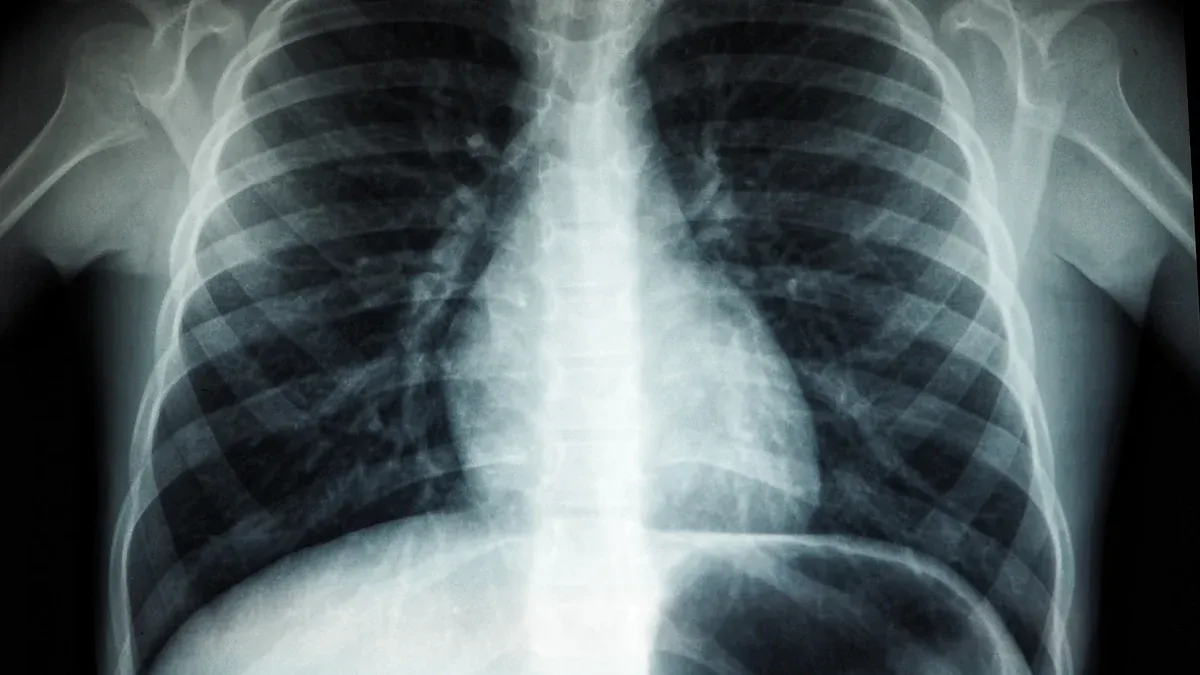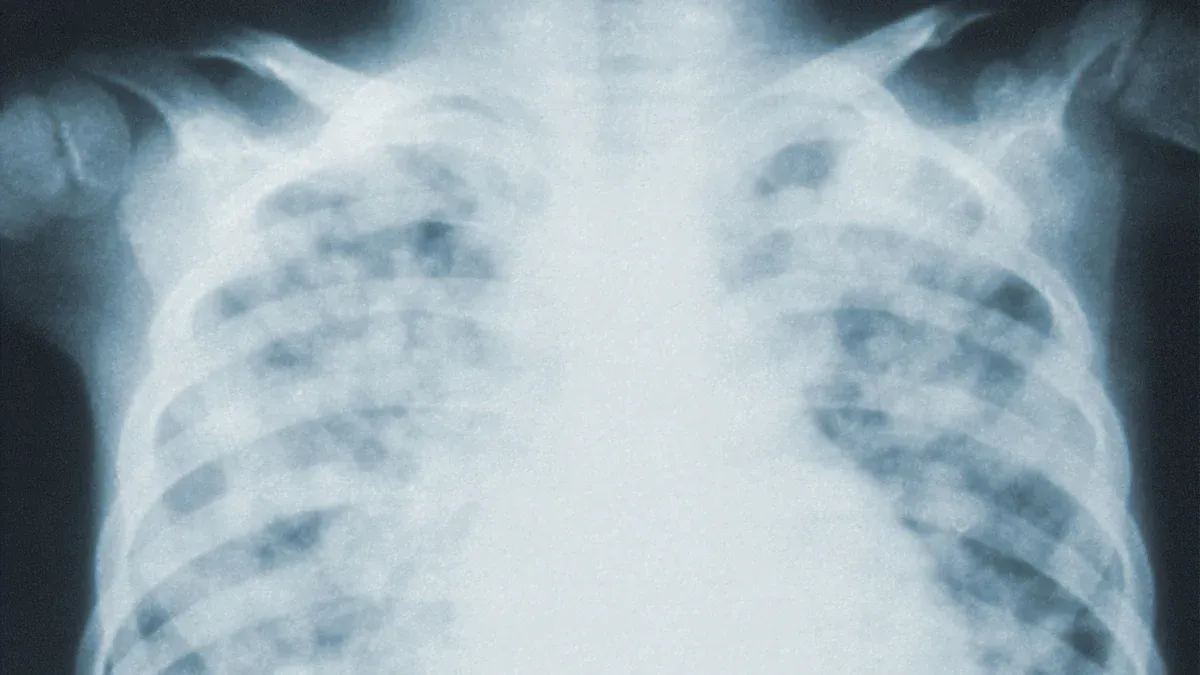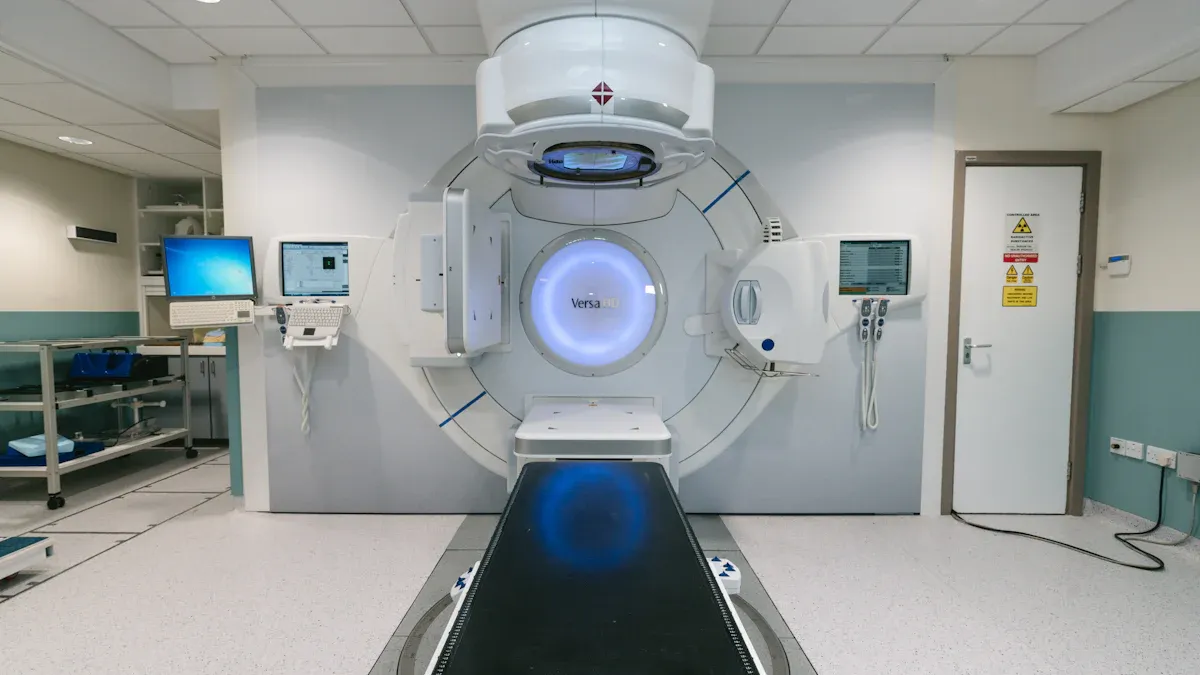Understanding Symptoms and Treatments for Non Small Cell Lung Carcinoma

Non small cell lung carcinoma is the most common type of lung cancer, making up approximately 80% to 85% of all cases. Recognizing symptoms early can greatly improve outcomes, as prompt treatment may render the disease curable. However, the prognosis is influenced by factors such as the stage of the cancer and overall health. Personalized care is essential in customizing treatments to meet your specific needs, improving both survival rates and quality of life. Gaining a clear understanding of non small cell lung carcinoma and its treatment options enables you to make well-informed decisions about your health.
Key Takeaways
Look for early signs like a long-lasting cough or weight loss. Finding it early can help treatments work better.
See a doctor if you notice these signs. Quick care can improve chances of living longer.
Learn why care made just for you matters. Special plans based on your health and cancer type work best.
Check out different treatments. From surgery to special medicines, knowing options helps you decide.
Think about comfort care anytime. It helps you feel better and manage symptoms, not only at the end of life.
Symptoms of Non Small Cell Lung Carcinoma

Common Symptoms
Persistent Cough
A persistent cough is one of the earliest signs you might notice. It often starts as a mild irritation but can worsen over time. If your cough doesn’t go away or becomes more severe, it’s important to consult a healthcare provider. In some cases, you may even notice blood in your sputum, which requires immediate attention.
Shortness of Breath
Shortness of breath, or dyspnea, can occur even during light activities. You might feel like you can’t catch your breath or experience wheezing. This symptom often results from the tumor blocking airways or fluid buildup in the lungs.
Chest Pain or Discomfort
Chest pain or discomfort may feel sharp or dull and can worsen when you breathe deeply, cough, or laugh. This symptom often indicates that the tumor is pressing on nearby tissues or nerves.
Tip: If you experience any of these symptoms, don’t ignore them. Early detection of non small cell lung carcinoma can significantly improve treatment outcomes.
Less Common Symptoms
Unexplained Weight Loss
Losing weight without trying can be a warning sign. This occurs because cancer cells consume a lot of energy, leaving your body with fewer resources.
Fatigue and Weakness
You might feel unusually tired or weak, even after resting. This symptom often stems from the body’s response to the cancer or from anemia caused by the disease.
Hoarseness or Voice Changes
Hoarseness or changes in your voice can occur if the tumor affects the nerves controlling your vocal cords. This symptom is less common but should not be overlooked.
Symptoms of Advanced Stages
Bone Pain
In advanced stages, cancer may spread to the bones, causing pain. You might feel this pain in your back, hips, or other areas. It can be constant or worsen at night.
Neurological Symptoms (e.g., Headaches, Dizziness)
If the cancer spreads to the brain, you might experience headaches, dizziness, or even seizures. These symptoms indicate that the disease has reached an advanced stage and requires immediate medical attention.
Note: Symptoms of non small cell lung carcinoma can vary widely. Always seek professional advice if you notice unusual changes in your health.
Diagnosing Non Small Cell Lung Carcinoma
Initial Evaluation
Medical History and Physical Examination
Your doctor will begin by reviewing your medical history and asking about symptoms like persistent cough, chest pain, or unexplained weight loss. They may also inquire about risk factors such as smoking or exposure to harmful substances. A physical examination will follow, focusing on your lungs and overall health.
Imaging Tests (e.g., Chest X-rays, CT Scans)
Imaging tests play a crucial role in identifying abnormalities in your lungs. A chest X-ray is often the first step, but CT scans provide more detailed images. These scans can detect calcifications, assess tumor size, and evaluate local invasion.
Advantages of CT Scans:
More sensitive than chest X-rays for detecting calcifications.
Helps differentiate between benign and malignant lesions.
Useful for evaluating primary tumors and nearby structures.
However, CT scans have limitations. They may not reliably identify mediastinal invasion or distinguish between certain cancer stages.
Diagnostic Tool | Description |
|---|---|
CT Scans | More sensitive than chest radiography; useful for detecting calcification and staging lung cancer. |
MRI | Lacks ionizing radiation; superior for evaluating local invasion and hilar lymphadenopathy. |
PET Scans | Assesses metabolic activity; useful for differentiating benign from malignant nodules and detecting metastases. |
Confirmatory Tests
Biopsy Procedures (e.g., Bronchoscopy, Needle Biopsy)
To confirm a diagnosis, your doctor may recommend a biopsy. Bronchoscopy is highly effective for central tumors, while transthoracic needle biopsy works well for peripheral lesions. Thoracoscopy or mediastinoscopy may be necessary for undiagnosed cases.
Biopsy Procedure | Sensitivity/Accuracy | Notes |
|---|---|---|
Sputum Cytology | 71% (central tumors) | Less than 50% for peripheral tumors; not commonly used due to low reliability. |
Bronchoscopy | 88% | Preferred for central tumors; sensitivity increases with transbronchial needle aspiration. |
Transthoracic Needle Biopsy | 74% (false-negative 26%) | Reliable for positive findings, but high false-negative rate makes it less useful for ruling out cancer. |
Needle Thoracentesis | 80% | Sensitivity with high specificity; recommended follow-up with thoracoscopy if negative. |
Thoracoscopy and Mediastinoscopy | N/A | Used for undiagnosed tumors after other procedures; important for managing malignant pleural effusions. |
Molecular Testing for Genetic Mutations
Molecular testing identifies genetic mutations that influence treatment options. For example, patients with EGFR mutations may benefit from targeted therapies like erlotinib. These therapies improve outcomes by addressing the specific genetic drivers of non small cell lung carcinoma.
Staging the Disease
TNM Staging System
The TNM staging system evaluates the size of the tumor (T), lymph node involvement (N), and the presence of metastases (M). This system helps determine the severity of the disease and guides treatment planning.
Key Points About TNM Staging:
Assesses tumor size and spread.
Evaluates lymph node involvement.
Identifies distant metastases.
Determining the Extent of Metastasis
Doctors use imaging tests like PET scans and MRIs to assess whether the cancer has spread to other parts of your body. This step is critical for determining the most effective treatment strategy.
Treatment Options for Non Small Cell Lung Carcinoma

Early-Stage Treatments
Surgery (e.g., lobectomy, pneumonectomy)
Surgery is often the first choice for treating early-stage non small cell lung carcinoma, especially in stages IA and IB. Procedures like lobectomy (removal of a lung lobe) or pneumonectomy (removal of an entire lung) aim to eliminate the tumor completely. For patients with good overall health, surgery offers the best chance of a cure. After surgery, doctors may recommend adjuvant therapies, such as chemotherapy or targeted therapy, to reduce the risk of recurrence.
Treatment Type | Description |
|---|---|
Surgery | Primary treatment for early-stage NSCLC. |
Adjuvant Therapy | Additional treatments post-surgery, including chemotherapy, targeted therapy, and immunotherapy. |
Radiation Therapy
Radiation therapy is another effective option for early-stage NSCLC, particularly for patients who cannot undergo surgery. High-energy rays target and destroy cancer cells, shrinking tumors and preventing their spread. This treatment is often combined with chemotherapy to enhance its effectiveness.
Tip: If surgery isn’t an option for you, ask your doctor about radiation therapy as a standalone treatment.
Advanced-Stage Treatments
Chemotherapy
Chemotherapy uses drugs to kill cancer cells or stop their growth. It is a common treatment for advanced stages of non small cell lung carcinoma. While chemotherapy affects both cancerous and healthy cells, it remains a cornerstone of treatment for many patients.
Targeted Therapy
Targeted therapies focus on specific genetic mutations in cancer cells, such as EGFR or ALK mutations. These treatments, like Osimertinib, are more precise and often cause fewer side effects than chemotherapy. They are particularly effective for advanced NSCLC and can work when traditional chemotherapy does not.
Key Benefits of Targeted Therapy:
Personalized treatment based on genetic testing.
Effective for advanced or metastatic NSCLC.
Immunotherapy
Immunotherapy boosts your immune system to fight cancer. Drugs like pembrolizumab and durvalumab have improved survival rates for advanced NSCLC. However, challenges include identifying which patients will benefit most and managing side effects.
Note: Immunotherapy may not work as well for patients with brain metastases or specific genetic profiles.
Combination Therapies
Chemoradiotherapy
Chemoradiotherapy combines chemotherapy and radiation therapy to treat non small cell lung carcinoma. This approach is often used for patients in good health who can tolerate aggressive treatment. It improves survival rates by attacking cancer cells from multiple angles.
Multimodal Approaches
Multimodal approaches integrate surgery, chemotherapy, radiation, and targeted therapies. These combinations are tailored to your specific condition, maximizing the chances of success. For example, maintenance chemotherapy after initial treatment can enhance progression-free survival.
Key Component | Description |
|---|---|
Chemotherapy Drugs | Includes cisplatin, carboplatin, and others. |
Targeted Agents | Used in three-drug combinations for better outcomes. |
Maintenance Chemotherapy | Enhances progression-free survival after initial treatment. |
Takeaway: Combination therapies offer a comprehensive approach to managing NSCLC, especially in advanced stages.
Palliative Care
Palliative care plays a vital role in managing non small cell lung carcinoma, especially when the disease progresses. It focuses on relieving symptoms and improving your overall well-being, regardless of the stage of your cancer.
Symptom Management
Palliative care helps you manage symptoms like pain, shortness of breath, and fatigue. Specialists use medications, therapies, and other interventions to address these issues effectively. For example, pain management might involve opioids or nerve blocks, while breathing difficulties could be eased with oxygen therapy or bronchodilators.
Tip: Communicate openly with your care team about any discomfort. This ensures they can tailor treatments to your needs.
In addition to physical symptoms, palliative care addresses emotional challenges. You may feel anxious or overwhelmed, and counselors or support groups can provide relief. This holistic approach ensures that both your body and mind receive the care they need.
Improving Quality of Life
Palliative care enhances your quality of life by focusing on what matters most to you. It provides clear communication about treatment options, helping you make informed decisions. You can work with your care team to establish goals that align with your values and preferences.
Key benefits of palliative care include:
Relief from pain and other symptoms.
Emotional and psychological support.
Guidance in understanding treatment choices.
Unlike common misconceptions, palliative care is not limited to end-of-life situations. You can benefit from it at any stage of non small cell lung carcinoma. By addressing your unique needs, it helps you maintain a sense of control and dignity throughout your journey.
Note: Palliative care is about living as well as possible, even with a serious illness.
Factors Influencing Treatment Decisions
Stage of the Disease
Localized vs. Metastatic Cancer
The stage of non-small cell lung carcinoma plays a critical role in determining your treatment options. Localized cancer, confined to the lungs, often allows for curative treatments like surgery or radiation therapy. In contrast, metastatic cancer, which has spread to other parts of the body, requires systemic therapies such as chemotherapy, targeted therapy, or immunotherapy.
Several factors influence the choice of treatment:
Your medical history and age.
Molecular features of the tumor, such as EGFR mutations.
Performance status, which assesses your ability to carry out daily activities.
Patients with specific genetic mutations, like EGFR or ALK, may benefit from targeted therapies. Immunotherapy, such as pembrolizumab, can improve survival rates for those with high PD-L1 expression. Even older patients with good performance status may tolerate combination chemotherapy, showing that age alone should not limit treatment options.
Patient-Specific Factors
Overall Health and Comorbidities
Your overall health significantly affects treatment decisions. Doctors consider factors like comorbidities and performance status to determine the best approach. For example, patients in good health may receive aggressive treatments like combined chemotherapy and radiation. Those with poorer health might only undergo radiation therapy or less intensive options.
Factor | Influence on Treatment Decision |
|---|---|
Comorbidity | Limits the available treatment options. |
Performance Status | Determines if aggressive treatments are suitable. |
Tumor-genomic Changes | Guides the use of targeted therapies. |
PD-L1 Expression | Helps decide immunotherapy eligibility. |
Genetic Mutations and Biomarkers
Genetic mutations and biomarkers guide personalized treatment plans. Driver mutations, such as EGFR or ALK, determine if targeted therapies are appropriate. High PD-L1 expression in tumors indicates that immunotherapy could be effective. These advancements allow treatments to focus on the unique characteristics of your cancer, improving outcomes and reducing side effects.
Treatment Goals
Curative Intent vs. Palliative Care
Treatment goals depend on the stage of your cancer and your overall health. Curative treatments aim to eradicate cancer and prolong survival. These include surgery, chemotherapy, and radiation therapy. For advanced stages, palliative care focuses on relieving symptoms and improving quality of life. Options like immunotherapy or radiation therapy can help manage disease-related symptoms while maintaining comfort.
Tip: Discuss your goals with your doctor to ensure your treatment aligns with your preferences and needs.
Recognizing the symptoms of non small cell lung carcinoma early, such as a persistent cough or unexplained weight loss, can significantly improve your chances of successful treatment. Early detection leads to better survival rates, as shown below:
Stage | |
|---|---|
Stage IA | 82% |
Stage IB | 68% |
Stage IIA | 50% |
Stage IIB | 40% |
Stage IIIA | 29% |
Stage IV | 10% (1-year survival) |
Treatment options range from surgery and radiation for early stages to chemotherapy, targeted therapy, and immunotherapy for advanced cases. Personalized care plays a vital role in improving outcomes.
"Early detection, early surgery, and early multimodality care at a comprehensive center like ours—all of these things are key to the best outcomes for anyone with this disease," says Roy Herbst, MD, PhD, a Yale Medicine oncologist.
Consulting a healthcare professional ensures you receive a tailored treatment plan that aligns with your specific needs and goals.
FAQ
What are the main risk factors for non-small cell lung carcinoma?
Smoking is the leading risk factor. Exposure to secondhand smoke, radon gas, asbestos, and air pollution also increases your risk. A family history of lung cancer may contribute as well.
Tip: Quitting smoking and reducing exposure to harmful substances can lower your risk significantly.
Can non-small cell lung carcinoma be detected early?
Yes, early detection is possible through screening methods like low-dose CT scans. These tests help identify lung cancer in its initial stages, even before symptoms appear.
Note: Screening is recommended for high-risk individuals, such as long-term smokers or those with a family history of lung cancer.
How does targeted therapy differ from chemotherapy?
Targeted therapy focuses on specific genetic mutations in cancer cells, making it more precise. Chemotherapy, on the other hand, attacks both cancerous and healthy cells. Targeted therapy often causes fewer side effects.
Treatment | Focus | Side Effects |
|---|---|---|
Targeted Therapy | Genetic mutations | Fewer |
Chemotherapy | All dividing cells | More |
Is immunotherapy effective for all patients?
Immunotherapy works best for patients with specific biomarkers, like high PD-L1 expression. It may not be effective for everyone. Your doctor will recommend tests to determine if you are a good candidate.
Emoji Reminder: 🧬 Biomarker testing is key to personalized treatment!
What lifestyle changes can help during treatment?
Eating a balanced diet, staying active, and managing stress can improve your overall well-being. Avoid smoking and limit alcohol consumption. These changes support your body during treatment and recovery.
Tip: Consult a nutritionist or physical therapist for personalized advice.
See Also
Exploring Symptoms and Treatment Options for LGL Leukemia
Insights Into Symptoms and Care for Adrenocortical Adenoma
Recognizing Symptoms and Treatment Approaches for Duodenal Cancer
Identifying Symptoms and Management Strategies for Choroid Plexus Carcinoma
Comprehending Symptoms and Therapeutic Options for Lymphomatoid Granulomatosis
